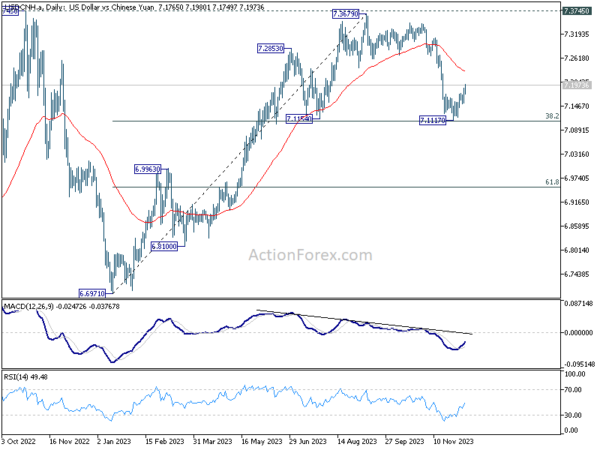Chinese Yuan weakens notably in Asian session today, setting its sights on crossing the 7.2 mark against Dollar. This movement is largely attributed to deepening deflation in consumer and factory prices in China, exerting downward pressure on the Yuan. Concurrently, Dollar is still riding the tailwind generated by last week’s robust job data.
A key question for Yuan is whether its extended decline, which began in January this year, concluded in September. And, if Yuan is now in a medium-term up trend that’s set to extend through 2024.
Some economists remain cautious about the currency’s prospects, pointing to the prolonged downturn in China’s housing market and consumer spending as significant drags on its value. Further impacting Yuan is the ongoing “de-risking” efforts by multinational corporations. These firms are increasingly adopting a “China+” strategy, diversifying their operations by adding plants and facilities in other countries, thereby diverting investments away from China. Moreover, these companies are likely to continue repatriating earnings, driven by China’s relatively low interest rates, which could further depress Yuan.
From a technical perspective, it remains to be confirm is USD/CNH’s fall from 7.3679 is a correction to the up trend from 6.6971, or reversing it.
The notable rebound from 7.1154 cluster support (38.2% retracement of 6.6971 to 7.3679 at 7.1117) is favoring the former case. Even so, sustained break of 55 D EMA (now at 7.2311) is needed to confirm completion of the pull back, and bring retest of 7.3679/3745 resistance zone.
On the other hand, sustained break of 7.1117/54 will favor the latter case of bearish trend reversal, and target 61.8% retracement at 6.9533 and below.
USD/CNH’s trajectory is not only crucial in understanding the Yuan’s movements but also serves as a valuable guide for USD/JPY. Additionally, it acts as a secondary indicator for the strength or weakness of AUD/USD.
















